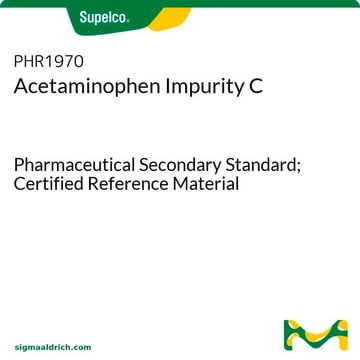PHR1150
Acetaminophen Related Compound F
Pharmaceutical Secondary Standard; Certified Reference Material
Synonim(y):
4-Nitrophenol, Paracetamol Impurity F, p-Nitrophenol
About This Item
Polecane produkty
klasa czystości
certified reference material
pharmaceutical secondary standard
Poziom jakości
agency
traceable to USP 1003064
ciśnienie pary
0.6 mmHg ( 120 °C)
rodzina API
acetaminophen, paracetamol
Certyfikat analizy
current certificate can be downloaded
temp. samozapłonu
541 °F
metody
HPLC: suitable
gas chromatography (GC): suitable
tw
279 °C (lit.)
mp
110-115 °C (lit.)
Zastosowanie
pharmaceutical (small molecule)
format
neat
temp. przechowywania
2-30°C
ciąg SMILES
O=N(C1=CC=C(O)C=C1)=O
InChI
1S/C6H5NO3/c8-6-3-1-5(2-4-6)7(9)10/h1-4,8H
Klucz InChI
BTJIUGUIPKRLHP-UHFFFAOYSA-N
Szukasz podobnych produktów? Odwiedź Przewodnik dotyczący porównywania produktów
Opis ogólny
Zastosowanie
Komentarz do analizy
Inne uwagi
Przypis
produkt powiązany
Hasło ostrzegawcze
Warning
Zwroty wskazujące rodzaj zagrożenia
Zwroty wskazujące środki ostrożności
Klasyfikacja zagrożeń
Acute Tox. 4 Dermal - Acute Tox. 4 Inhalation - Acute Tox. 4 Oral - STOT RE 2 - STOT RE 2 Oral
Organy docelowe
Kidney,Liver
Kod klasy składowania
6.1C - Combustible acute toxic Cat.3 / toxic compounds or compounds which causing chronic effects
Klasa zagrożenia wodnego (WGK)
WGK 2
Temperatura zapłonu (°F)
336.2 °F
Temperatura zapłonu (°C)
169 °C
Choose from one of the most recent versions:
Masz już ten produkt?
Dokumenty związane z niedawno zakupionymi produktami zostały zamieszczone w Bibliotece dokumentów.
Klienci oglądali również te produkty
Protokoły
Analytical standard separation of various phenols for research and industrial applications.
Nasz zespół naukowców ma doświadczenie we wszystkich obszarach badań, w tym w naukach przyrodniczych, materiałoznawstwie, syntezie chemicznej, chromatografii, analityce i wielu innych dziedzinach.
Skontaktuj się z zespołem ds. pomocy technicznej









